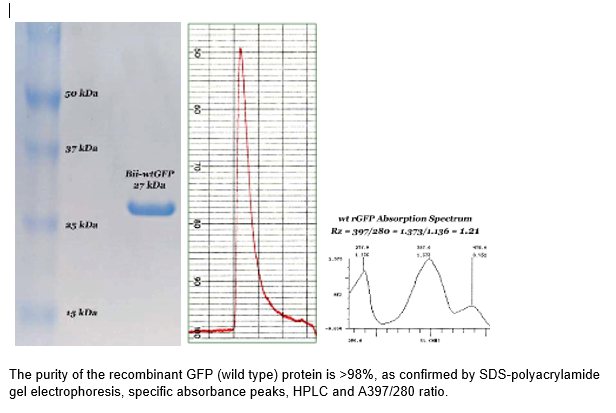
Purified recombinant Green Fluorescent Protein (wild type)
Catalog number: Bii-rGFP-100| Product Type |
Proteins & Peptides |
| Units | 0.1mg |
| Application |
ELISA Western Blotting |
Background
Green fluorescent protein (GFP) is a 27kD protein which was originally identified in the photo organs of Aequorea victoria (A. victoria) jellyfish. GFP is a naturally fluorescent protein which emits green light at a maximum wavelength of 509 nm when excited by blue or UV light. In A.victoria, calcium ions bind and activate the protein aequorin causing the release of blue fluorescence, which is then absorbed by GFP resulting in the release of green fluorescence. In the laboratory, the GFP protein has been used extensively as a reporter molecule to label, and study, cellular and subcellular proteins in living cells using a wide range of biological applications, including oncology, cardiovascular diseases, brain research, embryology and plant sciences, just to name a few. For the quantitation of the expression of a specific protein, tagged with GFP in these model systems, antibodies to GFP have proven to be of value in immunoblotting studies and ELISA protocols.
Source
Wild type recombinant GFP (from A.victoria) expressed in E.coli and purified by high resolution gel filtration.
Product
Each vial contains 100µg 1mg/ml purified recombinant GFP (wild type) in 10 mM TRIS buffer pH 8.0, containing 0.02% sodium azide.
Formulation: Each vial contains 100µg 1mg/ml purified recombinant GFP (wild type) in 10 mM TRIS buffer pH 8.0, containing 0.02% sodium azide.
Concentration: 1mg/ml
Specificity
The purity of the recombinant GFP (wild type) protein is >98%, confirmed by SDS-polyacrylamide gel electrophoresis, specific absorbance peaks, HPLC and A397/280 ratios.
Applications
Western Blotting|ELISA
Storage
The antibody may be stored at +4°C. For prolonged storage prepare appropriate aliquots and store at or below -20°C. Prior to use, an aliquot is thawed slowly in the dark at ambient temperature, spun down again and used to prepare working dilutions by adding sterile phosphate buffered saline (PBS, pH 7.2). Repeated thawing and freezing should be avoided. Working dilutions should be stored at +4°C, not refrozen, and preferably used the same day. If a slight precipitation occurs upon storage, this should be removed by centrifugation. It will not affect the performance or the concentration of the product.
Shipping Conditions: The antibody is shipped at ambient temperature
Caution
This product is intended FOR RESEARCH USE ONLY, and FOR TESTS IN VITRO, not for use in diagnostic or therapeutic procedures involving humans or animals. It may contain hazardous ingredients. Please refer to the Safety Data Sheets (SDS) for additional information and proper handling procedures. Dispose product remainders according to local regulations.This datasheet is as accurate as reasonably achievable, but Nordic-MUbio accepts no liability for any inaccuracies or omissions in this information.
References
Chalfie M, Tu Y, Euskirchen G, Ward WW, Prasher DC. (1994) Green fluorescent protein as a marker for gene expression. Science 263: 802-805.
Protein Reference(s)
Database Name: UniProt
Accession Number: UniProt: P42212 (A.victoria)
Safety Datasheet(s) for this product:
| NM_Sodium Azide |

|
Figure 1. The purity of the recombinant GFP (wild type) protein is >98%, as confirmed by SDS-polyacrylamide gel electrophoresis, specific absorbance peaks, HPLC and A397/280 ratio. |

Figure 1. The purity of the recombinant GFP (wild type) protein is >98%, as confirmed by SDS-polyacrylamide gel electrophoresis, specific absorbance peaks, HPLC and A397/280 ratio.
